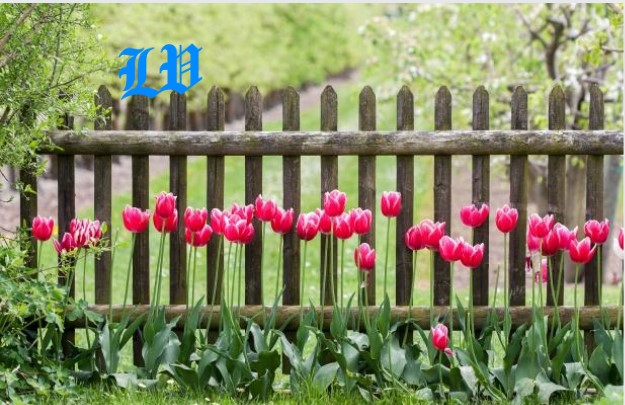blog
Garden Fences: Transform Your Outdoor Space with Stylish
Published
11 months agoon
By
Bilal
When it comes to designing and enhancing your outdoor space, garden fences play a crucial role. Not only do they provide privacy and security, but they also add aesthetic value to your garden. In this comprehensive guide, we’ll explore various garden fence ideas, including metal garden fences, decorative garden fences, small garden fences, wood garden fences, and more. Whether you’re looking for ideas for garden fences or specific options like garden fences and gates, this article has you covered.
The Importance of Garden Fences
Garden fences serve multiple purposes, making them an essential component of any garden design. They provide privacy, keeping your garden activities away from prying eyes. Additionally, garden fences protect your plants from pests and animals, ensuring a healthy and thriving garden. For those with children or pets, garden fences offer a safe and secure environment.
Moreover, garden fences can be a reflection of your personal style and enhance the overall aesthetic of your outdoor space. By choosing the right fence design, you can create a cohesive look that ties together various elements of your garden. Whether you prefer a rustic wooden fence or a sleek metal design, there are countless options to suit your taste.
Types of Garden Fences
1. Metal Garden Fences
Metal garden fences are known for their durability and strength. They come in various styles, from classic wrought iron to modern steel designs. Metal fences are ideal for those looking for a long-lasting solution that requires minimal maintenance. They can be both functional and decorative, adding a touch of elegance to your garden.
Advantages:
- Durability: Metal fences are highly durable and can withstand harsh weather conditions.
- Security: They provide a high level of security, making them ideal for protecting your property.
- Low Maintenance: Unlike wood, metal fences do not require regular painting or staining.
Disadvantages:
- Cost: Metal fences can be more expensive than other materials.
- Rust: Depending on the type of metal, rust can be an issue, although many modern fences are treated to prevent this.
2. Wood Garden Fences
Wood garden fences are a popular choice due to their natural appearance and versatility. They can be painted or stained to match your garden’s aesthetic. Wood fences are available in various styles, including picket, panel, and lattice. While they require more maintenance than metal fences, their timeless appeal makes them a favorite among homeowners.
Advantages:
- Aesthetics: Wood fences offer a natural and warm look that blends well with garden landscapes.
- Customizable: They can be easily painted or stained to match any color scheme.
- Variety: There are numerous styles and types of wood to choose from.
Disadvantages:
- Maintenance: Wood fences require regular maintenance, including painting, staining, and repairs.
- Durability: They are less durable than metal fences and can be susceptible to rot and insect damage.
3. Decorative Garden Fences
Decorative garden fences are designed to enhance the visual appeal of your garden. They come in a wide range of materials, including wood, metal, and PVC. These fences often feature intricate designs and patterns, making them a focal point in your garden. Decorative fences are perfect for those who want to add a unique touch to their outdoor space.
Advantages:
- Aesthetics: They add a decorative element to your garden, making it more visually appealing.
- Versatility: Available in various materials and designs to suit different tastes.
- Customization: Many decorative fences can be customized with different patterns and finishes.
Disadvantages:
- Cost: Decorative fences can be more expensive than simple, functional fences.
- Functionality: They may not provide as much privacy or security as other types of fences.
4. Small Garden Fences
Small garden fences are ideal for those with limited space. They can be used to create defined areas within a garden, such as flower beds or vegetable patches. Small fences are available in various materials and styles, allowing you to choose one that complements your garden’s overall design.
Advantages:
- Space Efficiency: Perfect for small gardens or specific sections of a larger garden.
- Aesthetics: Can add charm and structure to small spaces.
- Versatility: Available in various styles and materials to suit different needs.
Disadvantages:
- Limited Privacy: Small fences may not provide much privacy or security.
- Maintenance: Depending on the material, they may require regular upkeep.
5. Vegetable Garden Fences
For avid gardeners, vegetable garden fences are a must. These fences protect your vegetable patches from pests and animals, ensuring a bountiful harvest. They can be made from wood, metal, or mesh, depending on your needs. Vegetable garden fences can also be designed to be easily removable, allowing you to access your plants with ease.
Advantages:
- Protection: Keeps pests and animals away from your vegetables.
- Accessibility: Many designs allow for easy access to your plants.
- Customization: Can be tailored to fit the specific layout and size of your vegetable garden.
Disadvantages:
- Cost: High-quality vegetable garden fences can be expensive.
- Installation: Some designs may require professional installation.
Choosing the Right Garden Fence
Selecting the right garden fence depends on several factors, including your garden’s size, design, and purpose. Here are some tips to help you choose the perfect garden fence:
- Determine Your Needs: Consider the primary purpose of the fence. Is it for privacy, security, decoration, or plant protection?
- Material: Choose a material that complements your garden’s design and meets your maintenance preferences. For example, if you prefer a low-maintenance option, metal might be the best choice. If you love the look of natural materials, wood is a great option.
- Style: Select a fence style that enhances the overall aesthetic of your garden. Whether you prefer a classic picket fence or a modern steel design, make sure it fits with the rest of your outdoor decor.
- Budget: Determine your budget and choose a fence that offers the best value for your money. Remember to factor in installation and maintenance costs as well.
- Local Climate: Consider the weather conditions in your area. Some materials, like wood, may require more maintenance in wet climates, while metal fences might be more resistant to moisture.
Garden Fence Installation Tips
Installing a garden fence can be a DIY project or one that requires professional help, depending on the complexity. Here are some general tips for installing garden fences:
- Plan Your Layout: Measure your garden area and plan the fence layout. Mark the positions for posts and gates. Make sure to account for any slopes or uneven ground.
- Prepare the Ground: Clear the area of any debris or obstacles. Level the ground if necessary. This step ensures a stable foundation for your fence.
- Install Posts: Dig holes for the posts and secure them with concrete. Ensure they are aligned and level. Use a spirit level to check that each post is straight.
- Attach Panels or Rails: Once the posts are set, attach the fence panels or rails. Use appropriate hardware to secure them in place. Make sure each panel is level before securing it.
- Finish and Maintain: Apply any finishing touches, such as paint or stain. Regularly maintain your fence to ensure its longevity. Check for any signs of damage or wear and repair them promptly.
Creative Ideas for Garden Fences
1. Vertical Gardens
Transform your garden fence into a vertical garden by adding planters or trellises. This is a great way to maximize space and add greenery to your fence. You can grow flowers, herbs, or even vegetables vertically, creating a lush and vibrant garden wall. Vertical gardens are perfect for small spaces and can add a unique element to your garden design.
2. Mixed Material Fences
Combine different materials, such as wood and metal, to create a unique and stylish garden fence. Mixed material fences offer a modern look and can be customized to suit your garden’s design. This approach allows you to take advantage of the strengths of each material, such as the durability of metal and the natural beauty of wood.
3. Painted Fences
Add a splash of color to your garden by painting your fence. Choose colors that complement your garden’s theme and plant selections. A brightly painted fence can create a cheerful and inviting atmosphere. You can also use different colors to highlight certain sections of your garden or create patterns for added interest.
4. Recycled Materials
Use recycled materials, such as old doors or windows, to create an eco-friendly garden fence. This not only adds character to your garden but also promotes sustainability. Recycled materials can give your fence a unique, vintage look and reduce waste. Get creative and see what materials you can repurpose for your garden fence.
5. Living Fences
Consider planting a living fence, such as a hedge or a row of trees, to create a natural boundary for your garden. Living fences offer privacy and beauty while supporting local wildlife. Choose plants that are well-suited to your climate and soil conditions. With proper care, a living fence can become a lush, green barrier that enhances your garden.
Conclusion
Garden fences are more than just boundaries; they enhance the beauty and functionality of your outdoor space. Whether you’re looking for metal garden fences, wood garden fences, or decorative garden fences, there’s an option for every garden. By choosing the right fence and maintaining it properly, you can create a stunning and secure garden that you’ll enjoy for years to come. Explore the various ideas for garden fences and find the perfect one for your home today.

Who Is Lynn Hamilton? Celebrating the Life and Legacy of the American Actress

Who is Mickey Gooch Jr? The Dynamic Journey of a Film Producer and Actor

Who Is Pierre Bouvier? All About the Canadian Singer and Musician Behind Simple Plan

Who Is Pearl Minnie Anderson? Rising Star in Maya Rudolph’s Legacy

Who is Minnie Pearl? The American Comedian Who Brought Country Humor to the Spotlight

Who Is Kavan Smith? The Canadian Actor Known for His Versatile Roles

Who is Olivia Rose Cameron: The Creative Artist & Daughter of Kirk Cameron

Who Is Markella Kavenagh? All About the Australian Actress and Rising Star

Who is Tracey Hinds? Exploring the Life of Macy Gray’s Ex-Husband and Mortgage Broker

Who is Eric Weinberger? A Visionary Television Producer Shaping Sports Media

Who Is Dan Jeannotte? All About the Canadian Actor’s Career and Roles

Who Is Paul Fenech? Inside the World of the Australian Filmmaker and Actor

Who Is Merri Kelly Hannity? All About Sean Hannity’s Daughter

Who Is Diana Espinoza Aguilar? The Story of Rafael Caro Quintero’s Wife

Who is Charlee Fraser? The Rise of the Australian Model and Actress Making Global Waves

Who Is James Lesure? All About the American Film and Television Actor

Who is Eric Weinberger? A Visionary Television Producer Shaping Sports Media

Who Is Toru Ohtani? All About Shohei Ohtani’s Father & Baseball Coach

Who is Torrei Hart? The Multitalented Actress and Comedian Making Waves

Who Is Avantika Vandanapu? Rising American Actress & Singer

Who Is Lynn Hamilton? Celebrating the Life and Legacy of the American Actress

Who is Mickey Gooch Jr? The Dynamic Journey of a Film Producer and Actor

Who Is Pierre Bouvier? All About the Canadian Singer and Musician Behind Simple Plan

Who Is Pearl Minnie Anderson? Rising Star in Maya Rudolph’s Legacy

Who is Minnie Pearl? The American Comedian Who Brought Country Humor to the Spotlight

Who Is Kavan Smith? The Canadian Actor Known for His Versatile Roles

Who is Olivia Rose Cameron: The Creative Artist & Daughter of Kirk Cameron

Who Is Markella Kavenagh? All About the Australian Actress and Rising Star

Who is Tracey Hinds? Exploring the Life of Macy Gray’s Ex-Husband and Mortgage Broker

Who is Eric Weinberger? A Visionary Television Producer Shaping Sports Media
Trending
-

 Celebrity11 months ago
Celebrity11 months agoNecati Arabacı: Net Worth, Biography, and More
-

 Celebrity12 months ago
Celebrity12 months agoDiscovering Lily Phillips: An Insight into Her Life and Career
-

 Celebrity12 months ago
Celebrity12 months agoParker Schnabel’s Girlfriend: A Comprehensive Look at His Relationships Over the Years
-

 Celebrity11 months ago
Celebrity11 months agoEnrica Cenzatti: Life of Andrea Bocelli’s Ex-Wife
